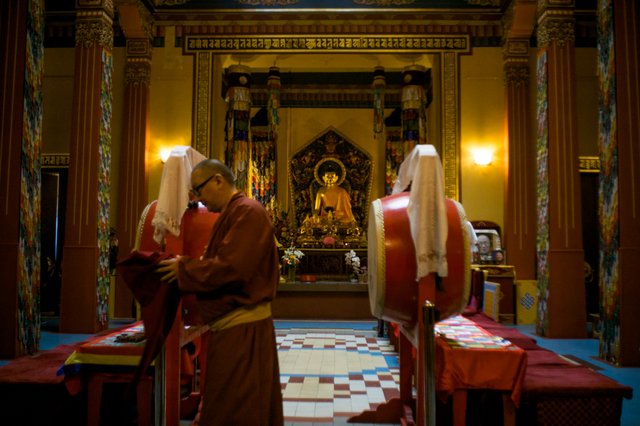
Сегодня у нас будет необычное путешествие. Не только посещение важного места, но и прикосновение к чему-то необычному. Сегодня это будут традиции буддизма, но только их внешняя видимая сторона. Я не являюсь адептом буддизма, как и любой другой мировой религии. Но это не значит, что я живу без Бога. Просто для общения с ним мне не нужны посредники. Я могу обратиться к нему своими мыслями и мы будем общаться.
Итак, мы посетим сегодня Дацан Гунзэчойнэй, который находится в Санкт-Петербурге.
The architectural project of the temple in accordance with the canons of Tibetan architecture was developed in 1909 by a student of the Institute of Civil Engineers N. M. Berezovsky and architect G. V. Baranovsky, the author of the project of the Eliseevsky grocery store on Nevsky. The construction was led by G. V. Baranovsky and R. A. Berzen (at the final stage). The funds needed for the construction were donated by Dorzhiev himself (30 thousand rubles), the Dalai Lama XIII (50 thousand rubles), the VIII Bogdo Gegen of Urga and collected among believers in Buryatia and Kalmykia. However, the actual costs far exceeded the amount indicated in the estimate by 151,694 rubles.
Construction continued from 1909 to 1915. The first Buddhist service was held on February 21, 1913 in honor of the 300th anniversary of the Romanov dynasty. The Buddha statue for the newly opened temple was donated by King Rama VI of Siam[1]. The consecration of the temple took place on August 10, 1915. Lama Agvan Lobsan Dorzhiev himself became the first abbot (shireete).
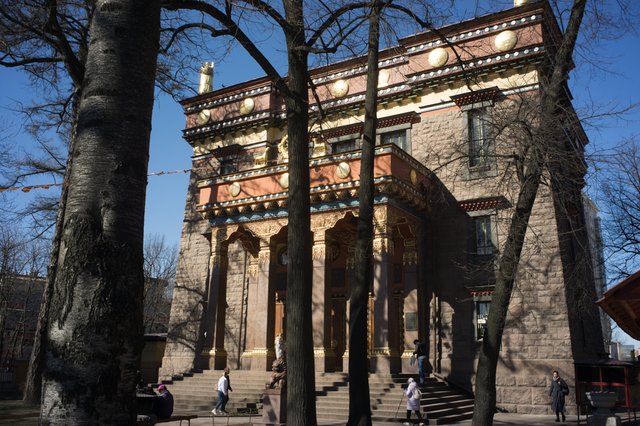
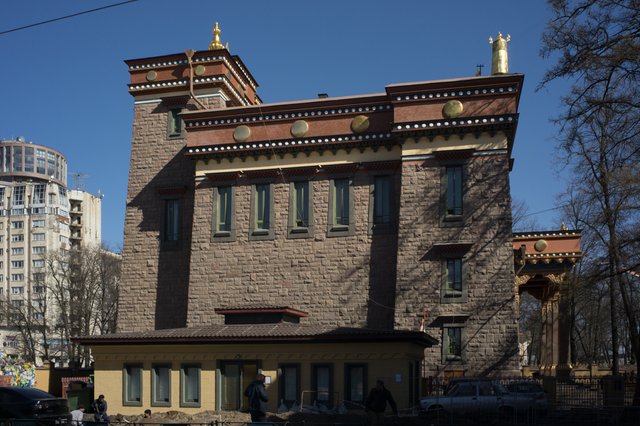
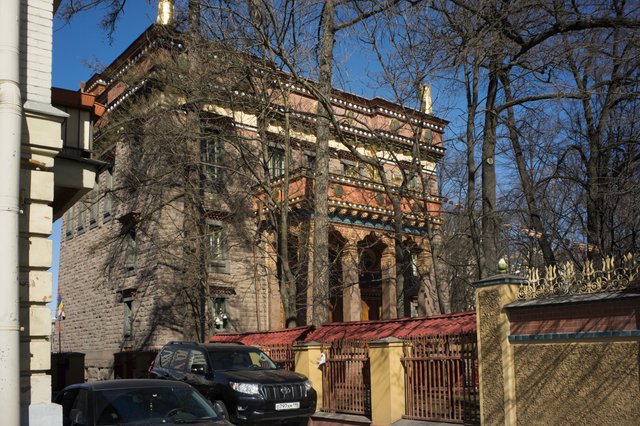
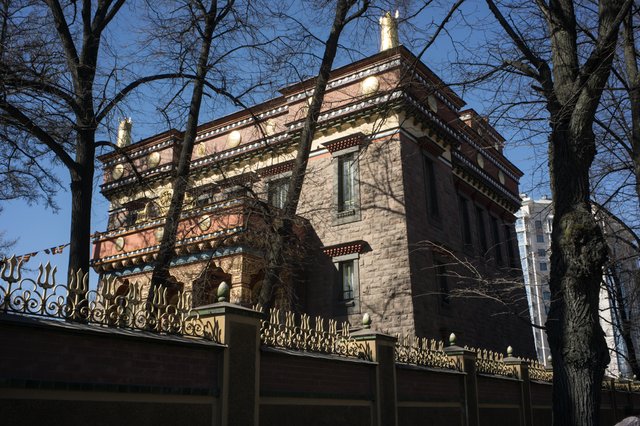
Near the entrance to the Datsan, the road was being repaired and we had to walk around the building. But I have the opportunity to show it to you from all sides.
Of course, this type of architecture is not typical for the city. But in St. Petersburg there is a very large mixture of styles, denominations, eras ... so, nothing surprising. But let's go to the inner courtyard.
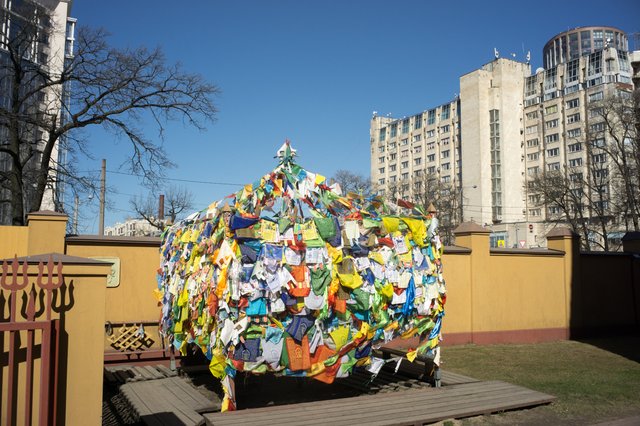
I am familiar with the Buddhist tradition of tying ribbons on trees. I don’t know for sure what this structure means, but apparently it has something in common with tying ribbons and making wishes. These bright rags are located to the left of the entrance to the courtyard.
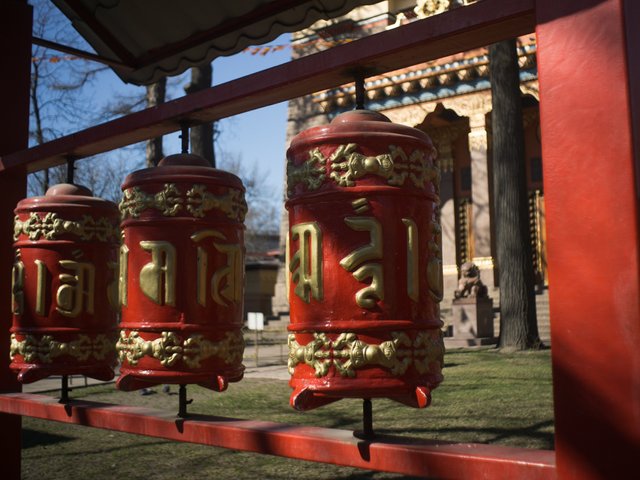
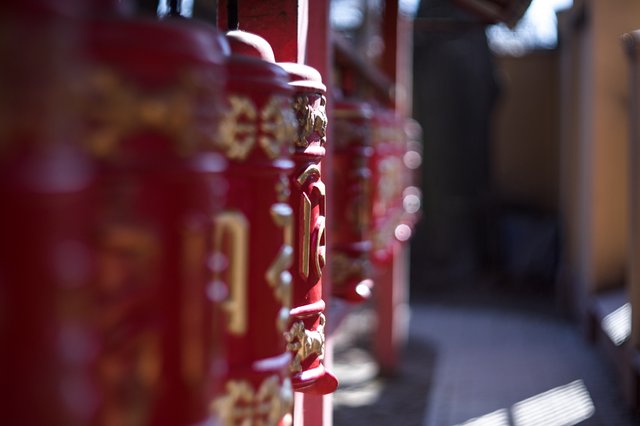
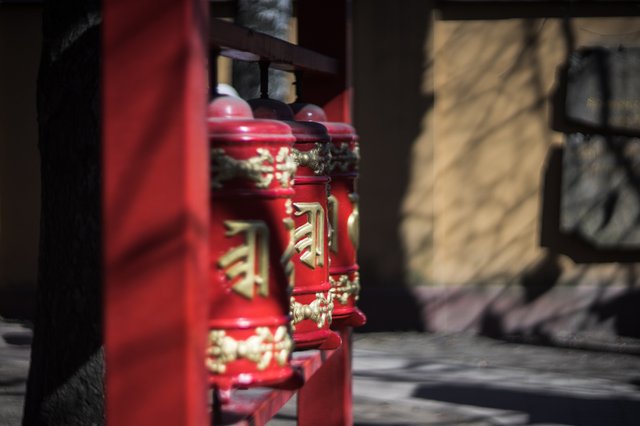
These prayer wheels are located along the perimeter of the courtyard. You should go clockwise and spin each of these reels.
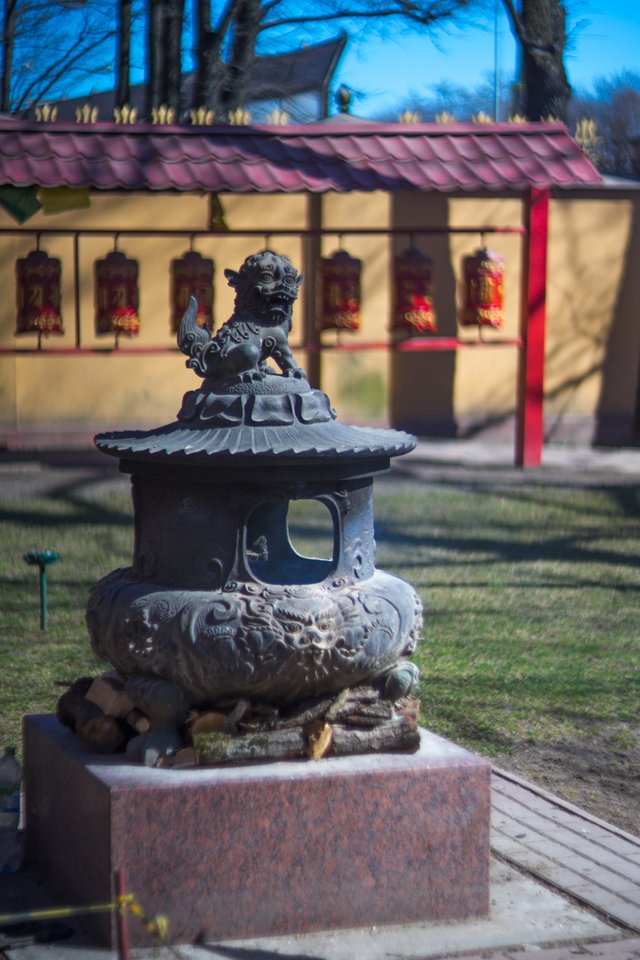
This guy's name is Shi Tza. I do not know how his name is translated into European languages, but it sounds beautiful. I mean the guy who sits on top of the censer - the hearth in which the incense smokes. This hearth is located almost in the center of the temple courtyard.
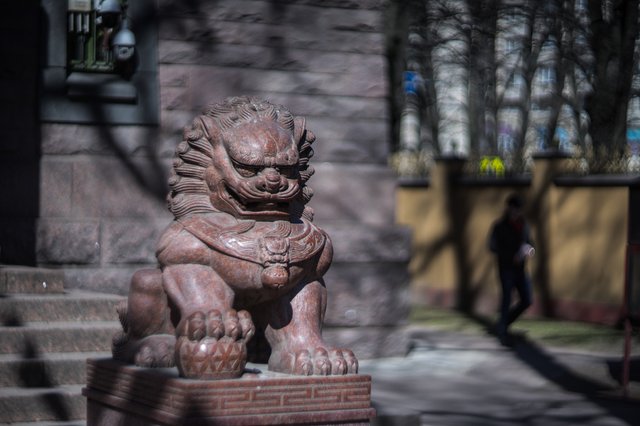
And this is one of the two senior Shi Tzu, they guard the entrance to the temple. Look at the expression on this lion's face, he's serious. But I decided to take a chance and go inside the datsan. Photography is prohibited there, but I couldn't resist showing you what's inside. Just a couple of shots, forgive me the monks, lamas and faithful guards of Shi Tza.
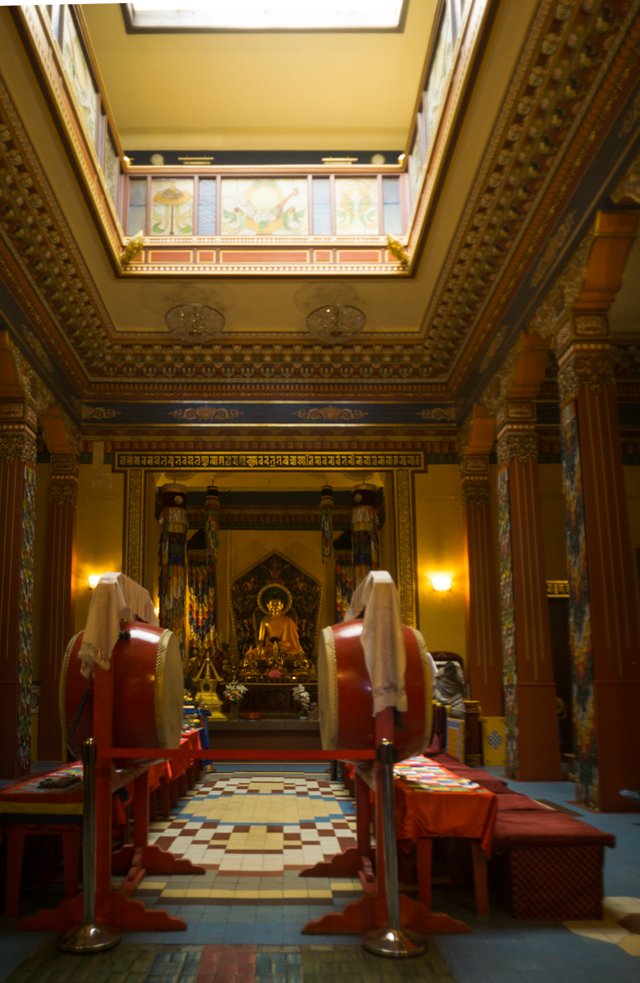
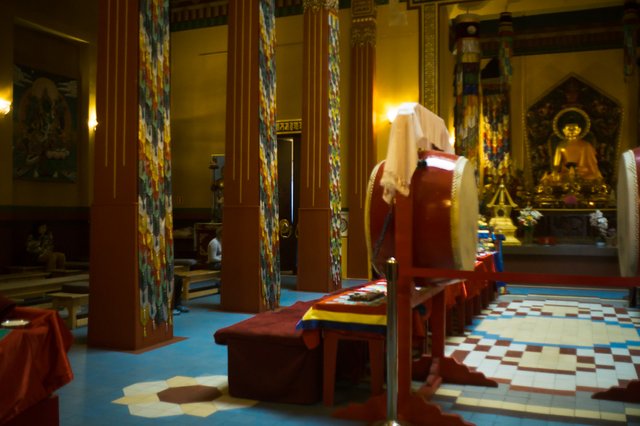
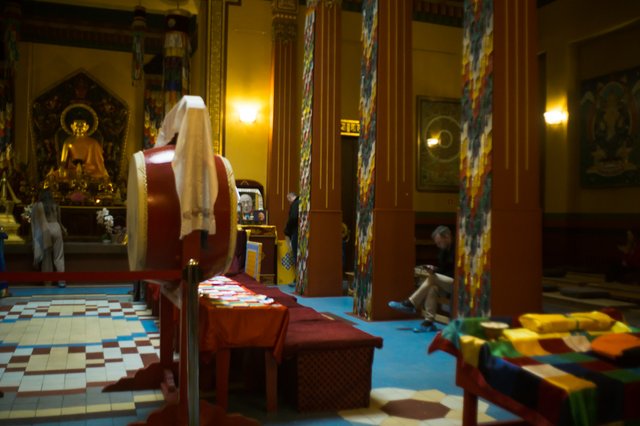
Чтобы вы могли сориентироваться на месте, я покажу вам карту города и точку, где находится это место.

By the way, on the second floor of the datsan, lamas receive visitors who seek solutions to everyday problems or health problems. They do not charge for this, but accept symbolic donations (if the visitor himself wishes).
The atmosphere in this datsan is very calm and friendly. You don't have to be a Buddhist to be there. Just come.

100% SP (manual translation to SP)

#club100
The time has come to build our own steem power

| ▽ | ▽ |
|---|---|
| Camera | Sony A7М2 |
| Lens | Helios-40-2 ОKS 1-22-1 |
| Location | Russia |
| Post-production | in LR |
Manual processing in Lightroom




SUBSCRIBE Here to join WORLD OF XPILAR Community
Regards, @bambuka
Seeing the images I thought that you have traveled to Tibet, that is amazing how authentically the place was built and how much love and effort was put into the whole idea and construction. Really nice!
You post is nominated for „@art-venture“ Support Program, @booming account upvote. Only the posts that are not cross posted, original and posted from Xpilar community page and using tag #art-venturehave priority. If your post gets approval, then you get upvote within few days. Good luck!
Downvoting a post can decrease pending rewards and make it less visible. Common reasons:
Submit
Yes, it's an amazing place. The real world of Buddhism has been created here.
Real lamas and monks serve in the datsans. The largest number of adherents are Buryats living in the city. And of course visitors.
Thanks for the support @stef1
Downvoting a post can decrease pending rewards and make it less visible. Common reasons:
Submit
Какой только архитектуры нет в Питере (как человек с архитектурным говорю), а такая "крепость" странно смотрится даже тут. Ну в смысле у Вас)
Все-таки наш буддизм должен быть каким-то бревенчатым что ли? Местным, досочным, каким-то)
Странно же выглядит, не?))
Downvoting a post can decrease pending rewards and make it less visible. Common reasons:
Submit
наш буддизм это что? ))
у нас буддисты в основном буряты, брёвна и доски - это ведичество и христианство скорее (и то раннее).
Проектировалось и строилось (я про дацан) согласно тибетских традиций.
Downvoting a post can decrease pending rewards and make it less visible. Common reasons:
Submit
Я про какое-то народное трактование буддизма, по чутью)
Downvoting a post can decrease pending rewards and make it less visible. Common reasons:
Submit
не, народное трактование здесь не прокатит)))
Он либо буддизм, либо нет. И там свои традиции и в обрядах и в постройках. Я понимаю, что кто0то и в юртах буддизм исповедует, но дацан есть дацан)))
Downvoting a post can decrease pending rewards and make it less visible. Common reasons:
Submit
Стало интересно - я -то думал буддизм проще относится к религиозной атрибутике, что он ближе к сути
Downvoting a post can decrease pending rewards and make it less visible. Common reasons:
Submit
ха, посмотри на традиционные тибетские или китайские храмы. Там всё состоит из "атрибутики" :)
Downvoting a post can decrease pending rewards and make it less visible. Common reasons:
Submit
ну, архитектура - она вся такая. особенно традиционная.
Я больше про идею. Идея попадая на другую почву, находит себе новые формы. И приспосабливается тем интереснее и лучше - чем она сама живее, не закоснела в "атрибутике". В вопросах религии - я идеалист, стараюсь смотреть в суть)
Downvoting a post can decrease pending rewards and make it less visible. Common reasons:
Submit
Дык... на какую другую почву, бурятская диаспора продолжает здесь свои традиции. Остальные "прихожане" скорее любопытствующие) типа меня.
Буддизм ни к чему не приспосабливается, ему зачем. Он есть такой, какой есть.
Ламы, конечно, ходят в кроссовках со смартфонами в карманах)), нно это просто жизнь такая сейчас.
А в вопросах веры у них всё строго, думаю, согласно традиции.
Downvoting a post can decrease pending rewards and make it less visible. Common reasons:
Submit
@bambuka can you contact me? This is my discord id
sathsara#4862
Downvoting a post can decrease pending rewards and make it less visible. Common reasons:
Submit
what issue do you want to talk about?
Downvoting a post can decrease pending rewards and make it less visible. Common reasons:
Submit
No any issues😘❤️ ..we are preparing curation team.. Would you like to join our team?
Downvoting a post can decrease pending rewards and make it less visible. Common reasons:
Submit
bambuka#1499
Downvoting a post can decrease pending rewards and make it less visible. Common reasons:
Submit
Your post is very interesting. I love the understated elegance of the building. Tibetan art and culture have always attracted me, I remember reading with great interest several years ago the book "The Third Eye" by Lobsang Rampa.
Thank you!
Downvoting a post can decrease pending rewards and make it less visible. Common reasons:
Submit
Glad to see you and thank you for your kind words!
I also like oriental culture. It is very spiritual and is aimed at goodness, nature and self-improvement. At one time, I was also fond of Tibetan culture and traditions. I like their attitude to life and they have a mystery.
Downvoting a post can decrease pending rewards and make it less visible. Common reasons:
Submit
Que informativo su post, sin duda arquitectura auténtica.
Downvoting a post can decrease pending rewards and make it less visible. Common reasons:
Submit
Muchas gracias @styngrey
Downvoting a post can decrease pending rewards and make it less visible. Common reasons:
Submit